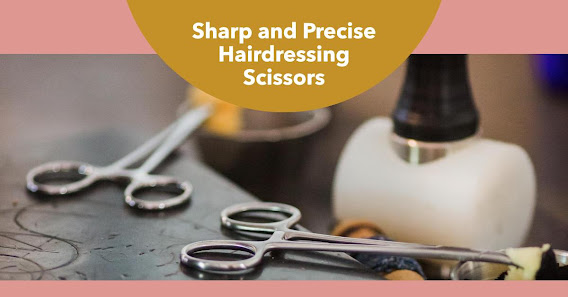Understanding the Different Types of Hairdressing Scissors and Their Uses
The choice of scissors for hairdressing plays a pivotal role in the artistry of hairstyling. These specialised tools are not just cutting instruments. They are the architects of precision and style.
Understanding the significance of selecting the right pair is paramount. Hairdressing scissors carefully tailored to specific needs, wield the ability to transform a simple cut into a masterpiece.
The synergy between the stylist's skill and the scissor's design determines the overall finesse of the haircut. When considering these scissors, acknowledging their diverse applications becomes essential.
Types of Hairdressing Scissors and Their Uses
Straight Blade Scissors:
Straight Blade Scissors, with their simple design, are versatile tools in hairdressing. These scissors boast a sharp, straight edge, ideal for creating precise and clean cuts.
When using scissors with straight blades, it is best suited for classic styles, providing sharp lines and defined shapes. They shine in foundational haircuts, ensuring a neat and polished look.
Use straight blades for cutting the length and establishing the initial shape of the hairstyle to maximise effectiveness. Hairstylists often rely on straight-blade scissors for traditional and timeless cuts.
When aiming for a sleek finish or a precise trim, these scissors prove indispensable, delivering accuracy and finesse.
Thinning Scissors:
Thinning Scissors, an essential in the hairstylist's toolkit, serve a unique purpose in hairdressing. Designed with serrated blades, they strategically remove bulk and add texture to the hair.
These scissors shine in scenarios where reducing thickness without sacrificing length is crucial. Hairstylists turn to thinning scissors for creating seamless layers and blending transitions.
Employ a gentle, feathering motion to use hairdressing scissors for thinning effectively. This technique prevents abrupt changes in texture, achieving a natural and flowing appearance. In the hands of skilled stylists, thinning scissors effortlessly transform dense hair into manageable and stylish tresses.
Texturising Scissors:
Texturising Scissors, with their unique features, add an artistic touch to hairstyling. These scissors come with notched or serrated edges, designed to create a soft and subtle texture in the hair.
Hairdressing scissors is used for texturising excel in enhancing movement and dimension. Incorporate them into a haircut to avoid a flat or uniform appearance.
Texturising scissors are favoured for crafting modern and trendy looks. Use these scissors sparingly to achieve the best results, focusing on areas where texture and movement are desired. Whether creating beachy waves or tousled layers, texturising scissors contribute to an effortlessly chic hairstyle.
Curved Blade Scissors:
Curved Blade Scissors introduce a dynamic element to hairdressing, offering benefits in both form and function. The curvature of the blades allows for ergonomic positioning, reducing strain on the stylist's hand and wrist.
Scissors with curved blades excel in achieving specific styles, particularly those involving intricate layering or curved shapes. Stylists appreciate the versatility of curved blades and seamlessly adapt to diverse haircut requirements.
When aiming for a softer, more natural look or intricate detailing, these scissors become invaluable. Their ergonomic design enhances precision, making them a staple in the hairstylist's arsenal for creating customised and stylish outcomes.
Offset and Crane Handle Scissors:
Differentiating between offset and crane-handle scissors involves understanding their ergonomic advantages and cutting techniques.
Offset scissors have a distinct handle design, promoting a natural hand position and reducing strain during prolonged use. Hairstylists often opt for offset-handle scissors for enhanced comfort.
On the other hand, crane-handle scissors feature a straight handle with a slight curve, offering a different grip style. The ergonomic benefits of these handles contribute to precise cutting, making them suitable for intricate detailing.
Choosing the right handle design for hairdressing scissors depends on personal comfort and specific hairstyle demands. Experimenting with both allows stylists to discover their preferred ergonomic fit for optimal performance.
Choosing the Right Scissors for Different Hair Types
Fine Hair:
Choosing the right scissors for fine hair involves opting for precision and delicate handling. Fine hair requires scissors with sharp blades to avoid split ends.
Consider using thinning scissors to add texture without compromising the hair's integrity. Hairstylists often recommend straight-blade scissors for fine hair. These scissors provide clean and precise cuts, giving the illusion of fuller hair.
When styling fine hair, avoid excessive thinning and opt for gentle layering to enhance volume. It is essential to choose hairdressing scissors that contribute to a lightweight and airy finish. It helps create a flattering look for those with fine strands.
Thick or Coarse Hair:
Tackling thick or coarse hair requires robust scissors designed for the task. Opt for scissors with sturdy, sharp blades to effortlessly navigate through dense strands.
Stylists often turn to texturising scissors for thick hair. These scissors help manage bulk while maintaining a natural appearance.
When styling thick or coarse hair, embrace layering to enhance movement and reduce heaviness. Thinning scissors prove invaluable in creating a balanced look without compromising thickness.
Choose hairdressing scissors that can handle the density of the hair. It helps ensure a polished finish that complements the individual's unique hair texture.
Curly Hair:
Cutting curly hair poses unique challenges, demanding specialised scissors for optimal results. Choose scissors that accommodate the natural curl pattern, promoting precision and reducing frizz.
Expert hairstylists often recommend curved-blade scissors. The curvature allows for seamless cutting along the curls, avoiding any disruptions to the natural pattern.
When working with curly hair, avoid aggressive thinning, as it can lead to an uneven appearance. Instead, focus on strategic layering to enhance the curls' bounce and definition.
It is crucial to select hairdressing scissors that embrace the curls' natural movement. Moreover, it helps create a customised and flattering look for those with curly hair.
Conclusion
Investing in quality hairdressing scissors becomes a cornerstone of success. Regular maintenance, including cleaning, sanitising, and sharpening, ensures longevity and optimal performance.
Stylists should embrace experimentation with different scissor types to elevate their skills. With this, they can cater to the unique demands of diverse hairstyles.

%20(1).jpg)


Comments
Post a Comment